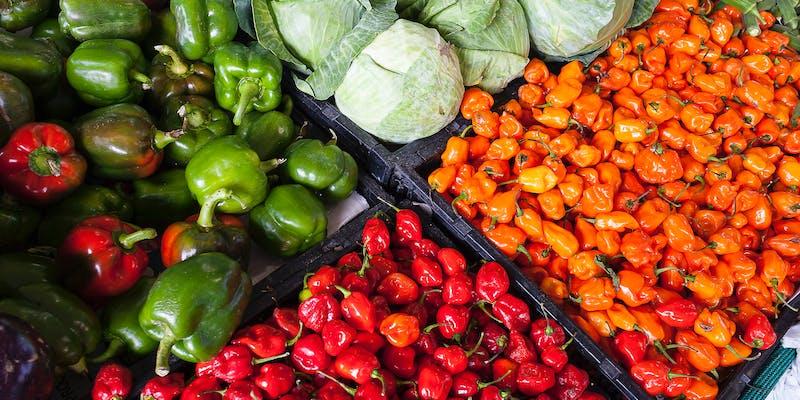Optimal Storage: High Vs. Low Humidity Conditions for Foods
Feb 24, 2024 By Madison Evans
Due to the cost reductions realized by purchasing large pack sizes, many individuals have altered their shopping patterns. You have arrived at a new dilemma if you have recently purchased food in mass, even though it further strains your budget. You must understand proper food storage practices to prevent the money you've saved from being wasted on deterioration.
High and Cold Humidity Foods
Fresh produce storage requires careful high humidity food storage and temperature management to extend shelf life. Specifically, many fruits and vegetables thrive around 32 °F and 95% relative humidity. Fruits and vegetables stay fresh longer in this chilly, wet environment.
Under these conditions, vegetables and fruits that flourish include cabbage, carrots, cauliflower, celery, collards, maize, asparagus, apples, beets, broccoli, radishes, parsley, parsnips, pears, peas, rhubarb, and spinach. In addition to preserving their flavor and quality, proper storage of foodstuffs provides a sustainable method of managing household goods by minimizing waste.
For generations, numerous cultures have employed root cellars and other cold, humid storage systems. Later, contemporary refrigeration systems make storage conditions easier to control, allowing people and corporations to keep produce fresher. The US Department of Agriculture says appropriate storage can boost fruit and vegetable post-harvest viability. This might halve food waste.
Before using these storage methods, you must know each product's needs. Apples and pears cannot develop faster than surrounding fruits and vegetables because they release ethylene gas in chilly settings. You can prevent unintended ripening by carefully placing them in the fridge or storage space.
Cold and Low Humidity Foods
Correct storage practices can substantially increase the longevity of garlic and scallions. Extending their shelf life to seven months is possible by preserving them at 32 degrees Fahrenheit and humidity levels ranging from 65 to 70 percent. This preservation technique guarantees these indispensable culinary components' prolonged freshness and usability.
Arid and low humidity foods conditions are critical for preserving additional pantry necessities, including meat, grains, flour, cereals, pasta, seasonings, herbs, sugar, salt, coffee, tea, and nuts. Ensuring the quality and prolonging the lifespan of these items are facilitated by these conditions. Commonly, meats are preserved for approximately three to four days after being refrigerated, a procedure followed in the kitchen. Long-term storage may be accomplished through chilling after this period. For best results, eat frozen meat within a few months of purchase.
Cool and High Humidity Foods

Some fruits and vegetables need the finest conditions to stay fresh. Ideally, the temperature and humidity should be 40–50 degrees Fahrenheit. This preservation method works well for cucumbers, tomatoes, watermelons, eggplants, peppers, and cantaloupes. These goods stay fresh for three weeks in the right conditions.
This storage strategy is supported by research and food preservation experts worldwide. A 2021 study found that high humidity food storage prevents moisture loss, extending produce shelf life. The US Department of Agriculture advises storing conditions to preserve perishable foods. This emphasizes food preservation, humidity, and temperature regulation.
Appropriate storage guarantees the safety and quality of perishable goods and substantially diminishes food waste, further underscoring the significance of such conditions during storage. Improper storage is a significant contributor to the roughly 14% of food lost before reaching consumers worldwide, as reported by the Food and Agriculture Organization of the United Nations. Households can emulate effective strategies employed in the food industry and promote reduced food waste and sustainable consumption patterns by conforming to the prescribed storage conditions.
Warm and Low Humidity Foods
To preserve one's harvest pure, discover the proper storage conditions. The appropriate conditions can boost the nutritional content and storage life of sweet potatoes, pumpkins, winter squash, and hot peppers. With adequate storage, these goods last three to six months, according to agricultural and household studies worldwide.
By aiming for a temperature range of 50 to 55 degrees Fahrenheit, one can locate the optimal location for these vegetables. Research indicates that adhering to this temperature range effectively inhibits the deterioration process, thereby safeguarding the texture and flavor of the food. Additionally, relative humidity is a crucial factor. Preserving the relatively high humidity food storage from 50 to 75 percent is not merely an arbitrary value; rather, it serves as a benchmark that corresponds with the moisture demands of these vegetables, averting their potential spoilage by drying out or becoming excessively damp.
Pumpkins, with their thick skin inherently susceptible to moisture damage, can last three months if properly stored. However, during these conditions, sweet potatoes, winter squash, and hot peppers will last six months. Historical evidence supports countries' winter harvest storage durations, not anecdotes.
The Impact of Humidity On Food

Food's Moisture
Food absorbs or loses water depending on humidity. Consider how humid indoor air currents pull moisture into crackers, making them brittle. Product texture and shelf life suffer. Fruits and vegetables may degrade faster in dry air. This dynamic equilibrium between food and air seeks a balance.
Keeping dried food in high humidity for lengthy durations reduces its quality by 60%, according to a 2018 study. Because they absorb more moisture, they degrade and alter texture. If stored at the right humidity, dry goods retain their crispness and resilience, extending their shelf life. To keep cereals and spices fresh, maintain relative humidity below 50%.
Microbial Growth
The small critters that can contaminate our food live anywhere there is water. Since they need water, mildew, bacteria, and yeast thrive in wet settings. These microorganisms flourish in moist circumstances, speeding up decomposition and endangering food safety. Thus, mold can swiftly colonize bread or cheese in exceptionally damp air.
Preventing food poisoning requires managing relative humidity, according to the FDA. According to 2020 research, food storage areas should have 30–50% relative humidity levels to avoid microbial infection. Customers' safety and well-being must come first in homes and enterprises.
Enzymatic Activity
Humidity affects food enzymes and maturation. In wet conditions, these enzymes accelerate fruit ripening, which might destroy if not managed appropriately. Low humidity foods inhibit these processes, keeping food fresher. Curious, Brazilian researchers presented a 2019 study demonstrating that managing humidity and temperature simultaneously could improve banana lifetime by 40%.
Food's Chemical Processes
Humidity impacts food's chemical processes as well as its physical qualities. In damp conditions, food's flavor, color, and nutritional value might change due to increased oxidation. This accelerates rancidity in lipids, oils, and food vitamins.
Researchers observed in 2021 that baked pastries and snacks stored in high-humidity settings lost almost 30% of their vitamin C content after two weeks. Preserving foods in controlled humidity levels preserves their nutritional content and quality. Foods must be packaged to prevent humid air exposure to avoid these effects and protect nutritional content.







